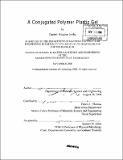A conjugated polymer plastic gel
Author(s)
Alcazar Jorba, Daniel
DownloadFull printable version (16.60Mb)
Other Contributors
Massachusetts Institute of Technology. Dept. of Materials Science and Engineering.
Advisor
Edwin L. Thomas.
Terms of use
Metadata
Show full item recordAbstract
We present a gel route to process highly oriented conjugated polymer films and fibers. The incorporation of hexafluoroisopropanol, a strong and stable dipolar group, to the polythiophene backbone enhances the solubility and especially, the hydrogen bond forming capabilities of the polymer. This functionalization enables the polymer to build up an isotropic self-supporting network structure based on a combination of polymer-polymer chain interactions and interchain hydrogenbondings. These thermally reversible physical crosslinks incorporate plasticity in the conjugated polymer gel. The gel network can be melted and then transformed via mechanical deformation to form an anisotropic gel with the chains highly aligned along the tensile direction. The oriented gel morphology comprises a distribution of crystalline clusters in an overall swollen network. In these ordered regions, conjugated backbones are [pi]-stacked with respect to each other neighbors. The mechanically induced structural rearrangement from an isotropic to an anisotropic conjugated polymer gel occurs when transitioning from the molten state to the gel state. This study highlights the versatility of incorporating plasticity in the design of conjugated polymer materials via a gel processing technology and its potential for applications.
Description
Includes bibliographical references (p. 107-119). Thesis (M. Eng.)--Massachusetts Institute of Technology, Dept. of Materials Science and Engineering, 2008.
Date issued
2008Department
Massachusetts Institute of Technology. Department of Materials Science and EngineeringPublisher
Massachusetts Institute of Technology
Keywords
Materials Science and Engineering.